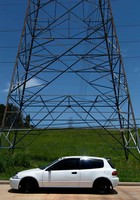Phone: (301) 352-5738
Email: info@CoastalClimateControl.com
Office | Warehouse:
1598 Whitehall Road, Suite D
Annapolis, Maryland 21409
A Re-Volting Thought

How’s everyone been out there? Hopefully, all are well and still kicking and screaming. I’m still lying low and pretty much operating under the radar, but I’ve been badgered lately to get fingers tapping on the keyboard again.
With winter approaching, and with the thought of storms and power outages energizing my little gray cells, I got to wondering just how long I could power up some essentials in the house using my Chevy Volt sitting in the driveway as a power plant.
Oh yes, it’s totally possible, there are tales from those who have done so on the internet, and there are even kits available.
 My Volt has a 17 kW-hr, 300v traction battery along with its DC generator plus a 12v battery for all the other normal loads. This 12v battery is charged by a DC-DC converter between the two batteries, so if I were to hook up an inverter to this battery I could supply 110v AC mains power to my household essentials during a power cut, or maybe power up an outdoor event, or fire up a blender and mini-fridge at a beach romp.
My Volt has a 17 kW-hr, 300v traction battery along with its DC generator plus a 12v battery for all the other normal loads. This 12v battery is charged by a DC-DC converter between the two batteries, so if I were to hook up an inverter to this battery I could supply 110v AC mains power to my household essentials during a power cut, or maybe power up an outdoor event, or fire up a blender and mini-fridge at a beach romp.
Possible? Yes, but for how long?
In theory, as the 12v battery is depleted it will be recharged from the traction battery, and when the traction battery gets low the built-in generator will kick in and charge it up. So, in theory if I leave the Volt switched on I could have 110v AC mains power for as long as there is gas in the tank.
Running the numbers suggests that with a fully charged traction battery and a full tank of gas there is around 145 kW-h total energy available. The DC-DC converter on the Volt is rated at 2 kW, so if I keep the power draw down to around 1kW so as not to smoke the thing, I’ll have 10 amps or so at 110v to play with.
Using a 1500 watt inverter should suffice to start and run the fridge, power a few lights, TV, computers, Wi-Fi gadgets, etc., plus the natural-gas powered water heater and maybe even the furnace as well. Even drawing 10 amps continuously at 110v AC, by my reckoning I should get over five days of power before having to refill the gas tank, and in normal intermittent and variable usage it could easily be double that. I just love my Volt!
The magic ingredient in this recipe is the DC-DC converter. These items have been slowly becoming more prevalent in marine/mobile installations and are available in increasingly more configurations and power rating options.
There are some that are true multi-stage battery chargers, and these can be used between batteries of different types that have different charging requirements, and batteries with either the same or different nominal voltages.
Victron has “Smart” models with Bluetooth that allow you to enter all the settings on your phone through an app, so you can set the charging voltages, limits, etc., to precisely what your battery manufacturer recommends.
DC-DC converters are designated as being either for banks of similar voltages, or in a “buck” configuration, where the voltage is reduced, or as a “boost” item where voltage is increased. In standard form you can charge a 12v battery from another 12v bank, and likewise in 24v format. Using a “buck” converter, you can charge a 12v battery from a 24v bank, while a “boost” model will allow you to charge a 24v battery from a 12v bank. Get the picture?
There are a whole host of other models available in different voltage configurations, and this reflects the rising popularity of DC propulsion and high-power DC systems and their associated high voltage battery banks.
These types of converters are not confined to use between two battery banks. They can be used on the output of alternators and other charging devices as buck or boost devices, and they can also be utilized to directly power DC loads that require a higher or lower voltage than that of the main battery.
At Coastal Climate Control we import some product in 12v configuration and then add a 24v-12v buck converter if the customer requests them to be powered by 24v.
Here’s another application: MPPT solar controllers are predominately in the buck configuration, as solar panels typically produce voltages that are too high to safely charge a battery. But some solar panels have voltage outputs that are too low to be able to charge a battery, especially a 24v bank. For those we’d have to use special boost controllers, which typically come with only basic features and are not configurable. However, by connecting a small, inexpensive boost DC-DC converter between the panel output and a regular buck solar controller, we can then utilize features and settings that are sadly missing from small boost controllers.
Over the years we’ve progressed from charging diodes to battery combiners and voltage sensitive relays (VSR’s). Now we have a wide variety of DC-DC converters to choose from, and they provide yet another option for boats with multiple battery banks, and for much more besides.
Uh oh. Looks like there's a storm a’comin’ my way. Time to gas up the Volt and get the extension cable ready.
By accepting you will be accessing a service provided by a third-party external to https://coastalclimatecontrol.com/






